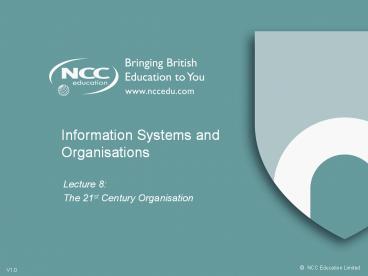Information%20Systems%20and%20Organisations - PowerPoint PPT Presentation
Title:
Information%20Systems%20and%20Organisations
Description:
Managers must master a new agenda for b web strategy if they intend to win in the new economy. (Tapscott, Ticol and Lowy, Digital Capital, p17) ... – PowerPoint PPT presentation
Number of Views:112
Avg rating:3.0/5.0
Title: Information%20Systems%20and%20Organisations
1
Information Systems and Organisations
- Lecture 8
- The 21st Century Organisation
2
Scope and Coverage
- This topic will cover
- Technology and changing organisational forms
- Commitment and control managing distributed
work - Evolving working practice and the network
organisation
3
Learning Outcomes
- By the end of this unit students will be able to
- Understand the way in which organisations and
work are changing under the influence of
technology - Critically analyse working practices and control
in the 21st century organisation
4
Contents
- How technology is changes working practices and
possibilities - Contemporary and future organisational forms
- Changing relationships with the organisation
- Management of distributed work
- Emphasis People, Organisation and Technology
5
How Technology Changes Work
- Most work in organisations is co-operative in
nature at some time or other - Eason identified important ways of characterising
such work in terms of - participants relative power and influence
- division of labour
- The classification scheme is on the next slide
6
Classification
Co-operative Work Classification, (Eason,1996,
p40)
7
Examples
- Type A Local division of labour and equality
e.g. decide amongst each other who does what - Type B Local division of labour and managed
contribution (team members supervisor) e.g.
fast-food restaurant - Type C Predetermined division of labour and
equality e.g. team of equal professionals - Type D Managed team of specialists
8
Transformation of Work Time Space
TIME TIME POWER AND INFLUENCE POWER AND INFLUENCE
SPACE Same (Synchronous) Different (Asynchronous) Division of Labour Equal Unequal
Same Location 1 2 Local A B
Different Location 3 4 Pre-determined C D
e.g. A traditional seminar ( 1 B )
... becomes an on-line forum ( 4 B )
Time-space and power-work type classification
transformation. Based on Hassall 1999 page 40.
9
Technology Effects
- Automating work
- De-skilling and up-skilling work
- Distributing work
- Changing discretion of individuals when doing
work - Changing times when work can be carried out
(whilst travelling perhaps) - Changing location and synchronism of work tasks
10
The Organisation Flow of Value Added
11
Outsourcing Secondary Activities
12
Concentrating on KEY Primary Activities
13
Organisation - Part of Business Networks
- If the corporation embodied capital in the
industrial age, then the b-web does the same for
the digital economy. In b-webs, internetworked,
fluid, sometimes highly structured, sometimes
amorphous-sets of contributors come together to
create value for customers and wealth for their
shareholders. In the most elegant of b-webs, each
participant focuses on a limited set of core
competencies, the things that it does best. - Business webs are inventing new value
propositions, transforming the rules of
competition, and mobilizing people and resources
to unprecedented levels of performance. Managers
must master a new agenda for b-web strategy if
they intend to win in the new economy. - (Tapscott, Ticol and Lowy, Digital Capital, p17)
14
Challenges for Management
- Relationship between people and their work
changing - Home-working, hot-desking , mobile and other
forms of work emerging - Blurring in online world between work and social
spheres - Competitive pressures
- Need to be able to manage networked contributions
and distributed work
15
Managing Distributed Work
Organisational characteristics
Societal
Individual characteristics
FIT
Outcomes
Work characteristics
Organisational
Individual
Technology characteristics
Based on, Boddy, Boonstra and Kennedy (2008),
page 229.
16
Replacing or Complementing Skills
- Consider a call centre
- The IS can automate more of less of the call
handlers task - Amount of discretion and skill will depend on
what the IS allows and the flexibility it
provides - Consider a modern garage company that services
cars - Computerised diagnostics can quickly isolate
engine faults, speeding the repair process - Repairs fitting/replacement parts still a manual
process
17
Human Contribution and Management
May enhance managers role
Enhance human contribution
MANAGERS
Information Systems
Limit human contribution
May diminish managers role
Based on, Boddy, Boonstra and Kennedy (2008)
figure 8.5 page 225
18
The 21st Century Organisation
- Flat Structure
- Networked business
- Distributed working
- Automation using IS where possible
- IS to enhance and control human contribution
- Partnerships with both Suppliers and Customers
- Concentrating on core value creating activities
19
References
- Boddy, D., Boonstra ,A., Kennedy, G. (2008)
Managing Information Systems strategy and
organisation 3rd ed. FT Pearson. ISBN-13
978-0273 -71681-5XXX - Tapscott, D. Ticoll, D. Lowy, A. (2000) Digital
Capital, Harnessing the Power of Business Webs,
Nicholas Brearley Publishing, ISBN 1 85788 209 1. - Hassall, J C, 1999, Developing Performance Models
for Co-operative Information Systems in an
Organisational Context, Doctor of Philosophy,
Aston University, July 1999
20
Lecture 8 The 21st Century Organisation
- Any Questions?






























